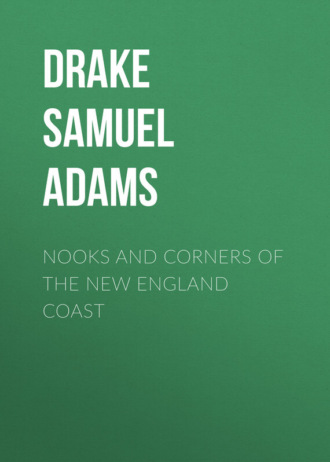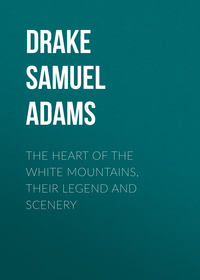 полная версия
полная версияNooks and Corners of the New England Coast
Pring, says Gorges, observing his instructions (to keep to the northward as high as Cape Breton), arrived safely out and back, bringing with him "the most exact discovery of that coast that ever came to my hands since; and indeed he was the best able to perform it of any I met withal to this present." Pring's relation wrought such an impression on Sir F. Gorges and Lord Chief-justice Popham that, notwithstanding their first disasters, they resolved on another effort. He had no doubt seen and talked with Gosnold after his return; perhaps had obtained from him his courses after he fell in with the coast.
The Speedwell, Pring's vessel, also made land in forty-three degrees. It proved to be a multitude of small islands. Pring, after anchoring under the lee of the largest, coasted the main-land with his boats. The narrative continues to relate that they "came to the mayne in 43½, and ranged to south-west, in which course we found several inlets, the more easterly of which was barred at the mouth. Having passed over the bar, we ran up into it five miles. Coming out and sailing south-west, we lighted upon two other inlets; the fourth and most westerly was best, which we rowed up ten or twelve miles." Between forty-three and forty-three and a half degrees are the Saco, then barred at the mouth,67 the Mousam, York, and the Piscataqua, the "most westerly and best."
"We (meeting with no sassafras)" – to follow the narrative – "left these places and shaped our course for Savage's Rocks, discovered the year before by Captain Gosnold." Savage Rock, then, was by both these accounts (Archer and Pring) to the southward of forty-three degrees, while the Nubble, or rather Agamenticus, is in forty-three degrees sixteen minutes.
"Departing hence, we bare into that great gulf which Captain Gosnold overshot the year before." This could be no other than Massachusetts Bay, for Gosnold, according to Brereton, after leaving Savage Rock, shaped his course southward ("standing off southerly into the sea") the rest of that day and night (May 15th), and on the following morning found himself "embayed with a mighty headland," which was Cape Cod. Pring, on the contrary, steered into the bay, "coasting, and finding people on the north side thereof." If my conjecture be correct, he was the first English mariner in Boston Bay.
It is hardly possible that a navigator falling in with the New England coast in forty-three or forty-three and a half degrees, and steering south-west, should not recognize in Cape Ann one of its remarkable features, or pass it by unperceived in the night. He would have been likely to find Savage Rock and end his voyage at the same moment. Champlain and Smith are both in evidence. The former, who examined the coast minutely two years after Pring (June, 1605), has delineated "Cap des Isles" on his map of 1612, which accompanied the first edition of his voyages. The account he gives of its position is as clear as that of Archer is obscure. Says the Frenchman, in his own way:
"Mettant le cap au su pour nous esloigner afin de mouiller l'ancre, ayant fait environ deux lieux nous apperçumes un cap a la grande terre au su quart de suest de nous ou il pouvoit avoit six lieues; a l'est deux lieues apperçumes trois ou quatre isles assez hautes et a l'ouest un grand cu de sac."
Here are the bearings of Cape Ann, the Isles of Shoals, and of Ipswich Bay defined with precision. Champlain also puts the latitude of Kennebunk River at forty-three degrees twenty-five minutes, which shows Pring could hardly have explored to the eastward of Cape Elizabeth. Smith, in 1614, described Cape Ann and Cape Cod as the two great headlands of New England, giving to the former the name of Tragabigzanda; but Champlain had preceded him, as Gosnold had preceded Champlain. On the whole, Gosnold, Pring, and Champlain agree remarkably in their latitude and in their itinerary.
At Cape Neddoek I "put up," or rather was put up – an expression applied alike to man and beast in every public-house in New England – at the old Freeman Tavern, a famous stopping-place in by-gone years, when the mail-coach between Boston and Portland passed this way. Since I knew it the house had been brushed up with a coat of paint on the outside, the tall sign-post was gone, and nothing looked quite natural except the capacious red barn belonging to the hostel. The bar-room, however, was unchanged, and the aroma of old Santa Cruz still lingered there, though the pretty hostess assured me, on the word of a landlady, there was nothing in the house stronger than small beer. It was not so of yore, when all comers appeared to have taken the famous Highgate oath: "Never to drink small beer when you could get ale, unless you liked small beer best."
The evening tempted me to a stroll down to the harbor, to see the wood-coasters go out with the flood. Afterward I walked on the beach. The full moon shone out clear in the heavens, lighting up a radiant aisle incrusted with silver pavement on the still waters, broad at the shore, receding until lost in the deepening mystery of the farther sea. The ground-swell rose and fell with regular heaving, as of Old Ocean asleep. As a breaker wavered and toppled over, a bright gleam ran along its broken arch like the swift flashing of a train. Occasionally some craft crossed the moon's track, where it stood out for a moment with surprising distinctness, to be swallowed up an instant later in the surrounding blackness. Boon Island had unclosed its brilliant eye – its light in the window for the mariner. It had been a perfect day, but the night was enchanting.
CHAPTER IX.
AGAMENTICUS, THE ANCIENT CITY
"Land of the forest and the rock,Of dark-blue lake and mighty river,Of mountains reared aloft to mockThe storm's career, the lightning's shock —My own green land forever."Whittier.Ho for Agamenticus! It is an old saying, attributed to the Iron Duke, that when a man wants to turn over it is time for him to turn out. As there are six good miles to get over to the mountain, and as many to return, I was early astir. The road is chiefly used by wood teams, and was well beaten to within half a mile of the hills. From thence it dwindled into a green lane, which in turn becomes a foot-path bordered by dense undergrowth. Agamenticus is not a high mountain, although so noted a landmark. There are in reality three summits of nearly equal altitude, ranging north-east and south-west, the westernmost being the highest. At the mountain's foot is a scattered hamlet of a few unthrifty-looking cabins, tenanted by wood-cutters, for, notwithstanding the axe has played sad havoc in the neighboring forests, there are still some clumps of tall pines there fit for the king's ships. You obtain your first glimpse of the hills when still two miles distant, the road then crossing the country for the rest of the way, with the mountain looming up before you.
Along shore, and in the country-side, the people call the mount indifferently "Eddymenticus" and "Head o' Menticus." Some, who had lived within a few miles of it since childhood, told me they had never had the curiosity to try the ascent. One man, who lived within half a mile of the base of the western hill, had never been on any of the others. The name is unmistakably of Indian origin. General Gookin, in his "Historical Collections of the Indians in New England," written in 1674, has the following in relation to the tribes inhabiting this region: "The Pawtuckett is the fifth and last great sachemship of Indians. Their country lieth north and north-east from the Massachusetts, whose dominion reacheth so far as the English jurisdiction, or colony of the Massachusetts, now doth extend, and had under them several other small sagamores, as the Pennacooks, Agawomes, Naamkeeks, Pascatawayes, Accomintas, and others."68
The climb is only fatiguing; it is not at all difficult. The native forest has disappeared, but a new growth of deciduous trees, with a fair sprinkling of evergreens, is fast replacing it. In some places the slender stems of the birch or pine shoot up, as it were, out of the solid rock. Following the dry bed of a mountain torrent, and turning at every step to wonder and admire, in half an hour I stood on the top. The summit contains an acre or more of bare granite ledge, with tufts of wiry grass and clumps of tangled vines growing among the crevices. Some scattered blocks had been collected at the highest point, and a cairn built. I seated myself on the topmost stone of the monument.
A solitary mountain lifting itself above the surrounding country is always impressive. Agamenticus seems an outpost of the White Hills, left stranded here by the glacier, or upheaved by some tremendous throe. The day was not of the clearest, or, rather, the morning mists still hung in heavy folds about the ocean, making it look from my airy perch as if sky and sea had changed places. Capes and headlands were revealed in a striking and mystical way, as objects dimly seen through a veil. Large ships resembled toys, except that the blue space grasped by the eye was too vast for playthings. Cape Elizabeth northward and Cape Ann in the southern board stretched far out into the sea, as if seeking to draw tribute of all passing ships into the ports between. Here were the Isles of Shoals, lying in a heap together. That luminous, misty belt was Rye Beach. And here was the Piscataqua, and here Portsmouth, Kittery, and Old York, with all the sea-shore villages I had so lately traversed. As the sun rose higher, the murky curtain was rolled away, and the ocean appeared in its brightest azure.
The sea is what you seldom tire of, especially where its nearness to the chief New England marts shows it crowded with sails bearing up for port. Craft of every build, flags of every nation, pass Agamenticus and its three peaks in endless procession – stately ships
"That court'sy to them, do them reverence
As they fly by on their woven wings."
Old Ocean parts before the eager prow. You fancy you see the foam roll away and go glancing astern. Here is a bark with the bottom of the Tagus, and another with the sands of the Golden Horn, sticking to the anchor-fluke; and here a smoke on the horizon's rim heralds a swifter messenger from the Old World – some steamship climbing the earth's rotundity; and yet water, they say, will not run up hill! When I looked forth upon this moving scene my lungs began to "crow like chanticleer." I waved my hat, and shouted "a good voyage" to sailors that could not hear me. I had no fear of listeners, for the Old Man of the Mountain tells no tales. To stand on a mountain-top is better, to my mind, than to be up any distance in a balloon. You have, at least, something under you, and can come down when you like. What a fulcrum Agamenticus would have made for the lever of Archimedes!
Landward, the horizon is bounded by the White Hills – the "Crystal Mountains, daunting terrible," of the first explorer.69 They look shadowy enough at this distance – seventy miles as the crow flies – Mount Washington, grand and grim, its head muffled in a mantle of clouds, overtopping all. The lofty ranges issuing from these resemble a broken wall as they stretch away to the Connecticut, with Moosehillock towering above.
"To me they seemed the barriers of a world,
Saying, 'Thus far, no farther!'"
The busy towns of Dover and Great Falls, with the nearer villages of Eliot and Berwick, are grouped about in picturesque confusion, a spire peeping out of a seeming forest, a broad river dwindling to a rivulet.
After feasting for an hour upon this sight, I became more than ever persuaded that, except in that rare condition of the atmosphere when the White Hills are visible far out to sea, Agamenticus must be the first land made out in approaching the coast anywhere within half a degree of the forty-third parallel. Juan Verazzani, perchance, certainly Masters Gosnold and Pring, saw it as plainly as I now saw the ships below me, where they had sailed.
I thought it fitting here, on the top of Agamenticus, with as good a map of the coast spread before me as I ever expect to see, to hold a little chat with the discoverers. If Hendrik Hudson haunts the fastnesses of the Catskills – and a veracious historian asserts that he has been both seen and spoken with – why may not the shade of Captain John Smith be lurking about this headland, where of yore he trafficked, and, for aught I know, clambered as I have done?
Right over against me, though I could not see them, were the Basque provinces, whose people the Romans could not subdue, and whose language, says the old French proverb, the devil himself could not learn. Cape Finisterre was there, with its shoals of sardines and its impotent conclusion of a name, as if it had been the end of the world indeed! Archer says, in his relation of Gosnold's voyage,70 that the day before they made the land they had sweet smelling of the shore as from the southern cape and Andalusia, in Spain. It was, says Brereton, "a Basque shallop, with mast and sail, an iron grapple and a kettle of copper, came boldly aboard of us." In 1578 there were a hundred sail of Spanish fishermen on the Banks of Newfoundland to fifty English. Spanish Biscay sent twenty or thirty vessels there to kill whales; France sent a hundred and fifty; and Portugal fifty craft of small tonnage to fish for cod. The Indians who boarded Gosnold could name Placentia and Newfoundland, and might have come from thence in their shallop, since they so well knew how to use it. But if Brereton's surmise was right, then some of those daring fellows from the Basse Pyrenees were first at Savage Rock. He says, "It seemed, by some words and signs they made, that some Basques, or of St. John de Luz, have fished or traded in this place, being in the latitude of 43 degrees."
Because there was no sassafras, it is not much we know about Savage Rock. The root of this aromatic tree was worth in England three shillings the pound, or three hundred and thirty-six pounds the ton, when Gosnold found store of it on the Elizabeth Islands; but as he was informed, "before his going forth that a ton of it would cloy England," few of his crew, "and those but easy laborers," were employed in gathering it. "The powder of sassafras," says Archer, "in twelve hours cured one of our company that had taken a great surfeit by eating the bellies of dog-fish, a very delicious meat."
That the medicinal qualities of sassafras were highly esteemed may be inferred from what is said of it in "An English Exposition," printed at Cambridge (England), in 1676, by John Hayes, printer to the University.
"Sassafras. – A tree of great vertue, which groweth in Florida, in the West Indies; the rinde herof hath a sweete smell like cinnamon. It comforteth the liver and stomach, and openeth obstructions of the inward parts, being hot and dry in the second degree. The best of the tree is the root, next the boughs, then the body, but the principal goodnesse of all resteth in the rinde."
One Master Robert Meriton, of Gosnold's company, was "the finder of the sassafras in these parts," from which it would appear that the shrub in its wild state was little known to these voyagers.
Coming down from my high antiquarian steed, and from Agamenticus at the same time, I walked back to the tavern by dinner-time, having fully settled in my own mind the oft-repeated question, the touch-stone by which even one's pleasures must be regulated, "Will it pay?" And I say it will pay in solid nuggets of healthful enjoyment, even if no higher aspirations are developed, in standing where at every instant man and his works diminish, while those of the Creator expand before you.
Douglass remarks that "Aquamenticus Hills were known among our sailors as a noted and useful land-making for vessels that fall in northward of Boston or Massachusetts Bay."
Leaving my comfortable quarters at Cape Neddock, I pursued my walk to Old York the same afternoon, taking the Long Sands in my way. It was farther by the beach than by the road, but as I was in no haste I chose the shore. I noticed that the little harbor I had quitted was so shallow as to be left almost dry by the receding tide, the channel being no more than a rivulet, easily forded within a few rods of the sea. Between this harbor and Wells Bay I had passed several coves where, in a smooth sea and during a westerly wind, small vessels were formerly hauled ashore, and loaded with wood at one tide with ease and safety. York Beach is about a mile across. I did not find it a long one.
It being low tide and a fine afternoon, the beach was for the time being turned into a highway, broader and smoother than any race-course could be, over which all manner of vehicles were being driven, from the old-fashioned gig of the village doctor to the aristocratic landau, fresh from town. The sands are hard and gently shelving, with here and there a fresh-water brooklet trickling through the bulk-head of ballast heaped up at the top by the sea. These little streams, after channeling the beach a certain distance, disappeared in the sand, just as the Platte and Arkansas sink out of sight into the plain.
There was a fresh breeze outside, so that the coasters bowled merrily along with bellying sails before it, or else bent until gunwale under as they hugged it close. The color of the sea had deepened to a steely blue. White caps were flying, and the clouds betokened more wind as they rose and unrolled like cannon-smoke above the horizon, producing effects such as Stanfield liked to transfer to his canvas. Mackerel gulls were wheeling and circling above the breakers with shrill screams. Down at low-water mark the seas came bounding in, driven by the gale, leaping over each other, and beating upon the strand with ceaseless roar.
The beach, I saw, had been badly gullied by the late storm, but the sea, like some shrewish housewife, after exhausting its rage, had set about putting things to rights again. I found shells of the deep-sea mussel, of quahaug and giant sea clam, bleaching there, but did not see the small razor-clam I have picked up on Nahant and other more southerly beaches.
The sea-mussel, as I have read, was in the olden time considered a cure for piles and hemorrhoids, being dried and pulverized for the purpose. William Wood speaks of a scarlet mussel found at Piscataqua, that, on being pricked with a pin, gave out a purple juice, dying linen so that no washing would wear it out. "We mark our handkerchiefs and shirts with it," says this writer.71 The large mussel is very toothsome. Like the oyster and clam, it was dried for winter use by the Indians.
The giant or hen clam-shell, found in every buttery within fifty miles of the coast, was the Indian's garden hoe. After a storm many clams would be cast up on the beaches, which the natives, taking out of the shells, carried home in baskets. A large shell will hold a plentiful draught of water, and is unequaled for a milk-skimmer. Only a part of the fish is used for food, as there is a general belief that a portion is poisonous, like the head of a lobster. Mourt's relation of the landing of the pilgrims at Cape Cod says they found "great mussels, and very fat and full of sea-pearle, but we could not eat them, for they made us all sicke that did eat, as well saylers as passengers." As they are only found on the beach after an easterly storm, they become well filled with sand, and require thorough cleansing before cooking, while those taken from the water near the shore are better, because free from sand. The common clam is not eaten along shore during the summer, except at the hotels and boarding-houses, not being considered wholesome by the resident population in any month that has not the letter R. The same idea is current with respect to the oyster. In either case the summer is inferior to the winter fish, and as Charles XII. once said of the army bread, "It is not good, but may be eaten."
There was but little sea-weed or kelp thrown up, though above high-water mark I noticed large stacks of it ready to be hauled away, containing as many varieties as commonly grow among the rocks hereaway. But there were innumerable cockles and periwinkles lately come ashore, and emitting no pleasant odor. The natives used both these shells to manufacture their wampum, or wampumpeag, the delicate inner wreath of the periwinkle being preferred. Now and then I picked up a sea-chestnut, or "whore's egg," as they are called by the fishermen. But the sand roller, or circle, is the curiosity of the beach as a specimen of ocean handicraft. I passed many of them scattered about, though a perfect one is rarely found, except on shallow bars beyond low-water mark. Looking down over the side of a boat, I have seen more than I was able to count readily, but they are too fragile to bear the buffeting of the surf. In appearance they are like a section taken off the top of a jug where the cork is put in, and as neatly rounded as if turned off a potter's lathe. Naturalists call them the nest of the cockle.
Going down the sands as far as the sea would allow, I remarked that the nearest breakers were discolored with the rubbish of shredded sea-weed, and by the particles of sand they held in solution. As I walked on, countless sand-fleas skipped out of my path, as I have seen grasshoppers in a stubble-field out West. The sandpipers ran eagerly about in pursuit, giving little plaintive squeaks, and leaving their tiny tracks impressed upon the wet sand. Little sprites they seemed as they chased the refluent wave for their food, sometimes overtaken and borne off their feet by the glancing surf. I remember having seen a flock of hens scratching among the sea-moss for these very beach-fleas in one of the coves I passed.
Old Neptune's garden contains as wonderful plants as any above high-water mark, though the latter do well with less watering. I have thought the botany of the sea worth studying, and, as it is sometimes inconvenient to pluck a plant or a flower when you want it, the beach is the place for specimens. Some years ago delicate sea-mosses were in request. They were kept in albums, pressed like autumn leaves, or displayed in frames on the walls at home. It was a pretty conceit, and employed many leisure fingers at the sea-side, but appears to have been discarded of late.
One day, during a storm, I went down to the beach, to find it encumbered with "devils' apron" and kelp, whitening where it lay. I picked up a plant having a long stalk, slender and hollow, of more than ten feet in length, resembling a gutta-percha tube. The root was firmly clasped around five deep-sea mussels, while the other end terminated in broad, plaited leaves. It had been torn from its bed in some sea-cranny, to be combined with terrestrial vegetation; but to the mussels it was equal whether they died of thirst or of the grip of the talon-like root of the kelp. There were tons upon tons of weed and moss, which the farmers were pitching with forks higher up the beach, out of reach of the sea, the kelp, as it was being tossed about, quivering as if there were life in it. I found the largest mass of sponge I have ever seen on shore – as big as a man's head – and was at a loss how to describe it, until I thought of the mops used on shipboard, and made of rope-yarns; for this body of sponge was composed of slender branches of six to twelve inches in length, each branching again, coral-like, into three or four offshoots. The pores were alive with sand-fleas, who showed great partiality for it.
What at first seems paradoxical is, that with the wind blowing directly on shore, the kelp will not land, but is kept just beyond the surf by the under-tow; it requires an inshore wind to bring it in. One who has walked on the beach weaves of its sea-weed a garland:
"From Bermuda's reefs, from edgesOf sunken ledges,On some far-off, bright Azore;From Bahama and the dashing,Silver-flashingSurges of San Salvador:""Ever drifting, drifting, driftingOn the shiftingCurrents of the restless main."I had before walked round the cape one way, and now, passing it from a contrary direction, had fairly doubled it. After leaving York Beach I pushed on for Old York, finding little to arrest my steps, until at night-fall I arrived at the harbor, after a twenty-mile tramp, with an appetite that augured ill for mine host.
It was not my first visit to Old York, but I found the place strangely altered from its usual quiet and dullness. The summer, as Charles Lamb says, had set in with its usual severity, and I saw fishers in varnished boots, boatmen in tight-fitting trowsers, and enough young Americans in navy blue to man a fleet by-and-by. Parasols fluttered about the fields, and silks swept the wet floor of the beach. I had examined with a critical eye as I walked the impressions of dainty boots in the sand, keeping step with others of more masculine shape, and marked where the pace had slackened or quickened, and where the larger pair had diverged for a moment to pick up a stone or a pebble, or perchance in hurried self-communing for a question of mighty import. Sometimes the foot-prints diverged not to meet again, and I saw the gentleman had walked off with rapid strides in the opposite direction. For hours on the beach I had watched these human tracks, almost as devious as the bird's, until I fancied I should know their makers. Not unfrequently I espied a monogram, traced with a stick or the point of a parasol, the lesser initials lovingly twined about the greater. Faith! I came to regard the beach itself as a larger sort of tablet graven with hieroglyphics, easy to decipher if you have the key.











